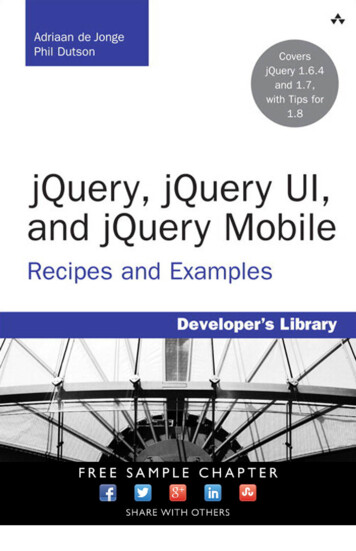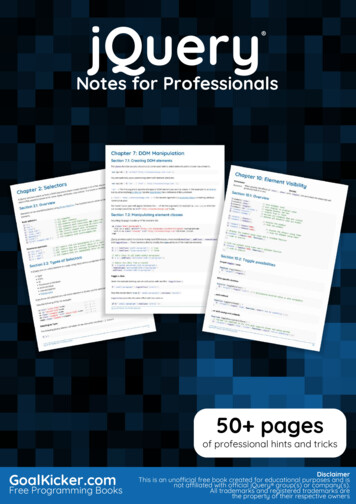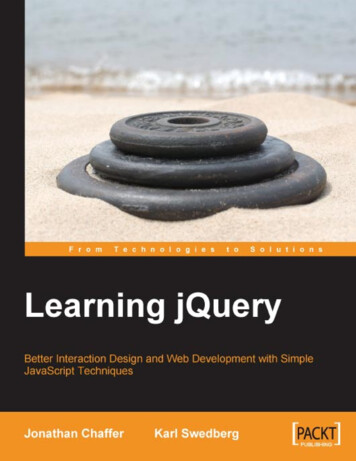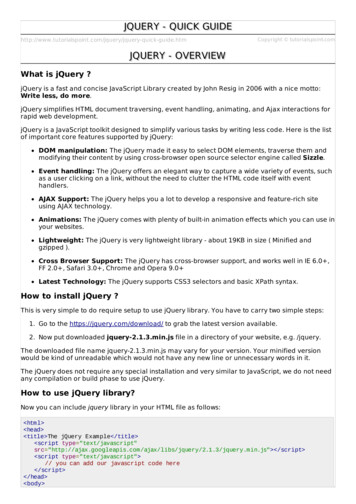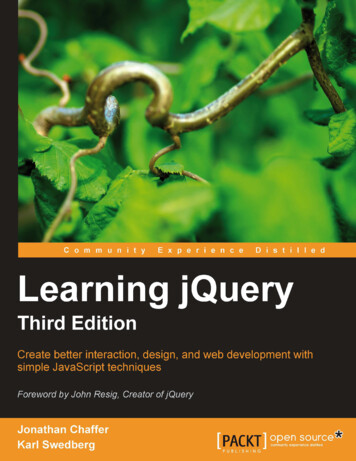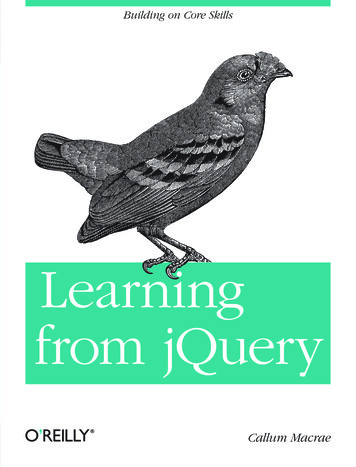
Transcription
Learning from jQueryCallum Macrae
Learning from jQueryby Callum MacraeCopyright 2013 Callum Macrae. All rights reserved.Printed in the United States of America.Published by O’Reilly Media, Inc., 1005 Gravenstein Highway North, Sebastopol, CA 95472.O’Reilly books may be purchased for educational, business, or sales promotional use. Online editions arealso available for most titles (http://my.safaribooksonline.com). For more information, contact our corporate/institutional sales department: 800-998-9938 or corporate@oreilly.com.Editors: Simon St.Laurent and Meghan BlanchetteProduction Editor: Rachel SteelyFebruary 2013:Copyeditor: Rachel MonaghanProofreader: Kiel Van HornCover Designer: Randy CornerInterior Designer: David FutatoIllustrator: Rebecca DemarestFirst Edition.Revision History for the First Edition.:2013-01-28First releaseSee http://oreilly.com/catalog/errata.csp?isbn 9781449335199 for release details.Nutshell Handbook, the Nutshell Handbook logo, and the O’Reilly logo are registered trademarks ofO’Reilly Media, Inc. Learning from jQuery, the image of a green broadbill, and related trade dress aretrademarks of O’Reilly Media, Inc.Many of the designations used by manufacturers and sellers to distinguish their products are claimed astrademarks. Where those designations appear in this book, and O’Reilly Media, Inc., was aware of atrademark claim, the designations have been printed in caps or initial caps.While every precaution has been taken in the preparation of this book, the publisher and author assumeno responsibility for errors or omissions, or for damages resulting from the use of the information contained herein.ISBN: 978-1-449-33519-9[LSI]
Table of ContentsPreface. . . . . . . . . . . . . . . . . . . . . . . . . . . . . . . . . . . . . . . . . . . . . . . . . . . . . . . . . . . . . . . . . . . . . . . vii1. Event Handling. . . . . . . . . . . . . . . . . . . . . . . . . . . . . . . . . . . . . . . . . . . . . . . . . . . . . . . . . . . . . . 1Listening for EventsEvents in jQueryEvents in JavaScriptEvents in Internet Explorer 8Writing a Wrapper FunctionAdding Event Handlers to Multiple ElementsEvent PropagationInternet Explorer’s .attachEventTriggering EventsTriggering Events in Internet Explorer 8Writing a Wrapper Function to Trigger EventsRemoving Event HandlersRemoving Event Handlers in Internet Explorer 8Writing a Wrapper Function to Remove EventsAdding a “Once Only” Event ListenerSummary11223571011131314151516172. Constructors and Prototypes. . . . . . . . . . . . . . . . . . . . . . . . . . . . . . . . . . . . . . . . . . . . . . . . . 19ConstructorsMethod ChainingConstructor, Not FunctionPrototypes.hasOwnPropertyEditing the Prototype of Existing ObjectsSummary192021222424253. DOM Traversal and Manipulation. . . . . . . . . . . . . . . . . . . . . . . . . . . . . . . . . . . . . . . . . . . . . 27iii
Selecting an ElementSelecting Elements with a CSS SelectorSelecting ChildrenSelecting the Next ElementCreating an ElementModifying an Existing ElementCycling Through ElementsMoving and Copying ElementsSummary2728293031313333344. AJAX. . . . . . . . . . . . . . . . . . . . . . . . . . . . . . . . . . . . . . . . . . . . . . . . . . . . . . . . . . . . . . . . . . . . . . 35Sending an AJAX RequestDebuggingDebugging Sent AJAX RequestsSending POST Requests in JavaScriptWriting a Wrapper FunctionA Simple Application of AJAXDesigning a Site with AJAXSummary35363737383941415. JavaScript Conventions. . . . . . . . . . . . . . . . . . . . . . . . . . . . . . . . . . . . . . . . . . . . . . . . . . . . . . 43Writing JavaScriptCommentsCoding StandardsLiterals NotationObject LiteralsOther LiteralsOptimizationsAlgorithmsCaching VariablesparseIntLoopsMinimize Repeated ExpressionsFunctionsDeclarations Versus ExpressionsFunction CallbacksIf Invoking Self-Defining FunctionsCode ReuseCommon AntipatternsUsing evalwithdocument.writeiv Table of Contents434346505051515252535354545455565858595960
Common Design PatternsThe Singleton PatternThe Factory PatternThe Iterator PatternThe Facade PatternSummary606162636465A. JavaScript Basics. . . . . . . . . . . . . . . . . . . . . . . . . . . . . . . . . . . . . . . . . . . . . . . . . . . . . . . . . . . . 67B. JavaScript Resources. . . . . . . . . . . . . . . . . . . . . . . . . . . . . . . . . . . . . . . . . . . . . . . . . . . . . . . . 97Table of Contents v
PrefaceMany developers are comfortable with using the jQuery library, which adds featuresto JavaScript and makes a lot of tasks easier, but they are slightly less confident whenusing JavaScript without jQuery. This could be because they don’t like the syntax ofJavaScript and so try to avoid writing pure JavaScript as much as possible, or it couldjust be because they’re hoping that they’ll never have to work on a project where theycan’t use jQuery. Whatever the reason, this can result in the parts of their code thataren’t using jQuery being inefficient or incorrect.If any of this sounds like you, then this book provides an opportunity for you to expandyour knowledge of the bits of JavaScript that jQuery covers up for you. In the first fourchapters, we’ll cover event handling, prototypes, working with the DOM, and AJAX.Chapter 5 is about conventions in JavaScript, and covers some common conventionsand patterns in JavaScript. There are also two appendixes: Appendix A aims to teachJavaScript to someone who has never written it without jQuery before, and Appendix B highlights some useful tools that you can use to aid you when coding.You can find all the major functions from this book, such as the AJAX and eventfunctions, and some additional code samples, on this GitHub repo.Who This Book Is ForThis book is targeted at developers who know jQuery, but who don’t yet feel confidentin their JavaScript knowledge or would just like to know more. You don’t need to knoweverything there is to know about jQuery, as I’ll be explaining what something doesif it isn’t already obvious—for example, I wouldn’t explain what .fadeIn() does, as itis descriptive enough that it doesn’t require explanation.vii
Who This Book Isn’t ForThis book assumes a basic knowledge of jQuery, and I wouldn’t recommend readingit if you have no experience in JavaScript or jQuery. If that describes you, I wouldrecommend finding a basic JavaScript book such as Michael Morrison’s Head FirstJavaScript, David Sawyer McFarland’s JavaScript and jQuery: The Missing Manual, orShelley Powers’s Learning JavaScript. For a more comprehensive exploration, try DavidFlanagan’s JavaScript: The Definitive Guide.While it certainly won’t hurt, this book wasn’t written for you if you already consideryourself fairly good with JavaScript, and you may not learn much. You won’t havecovered everything in the book (especially in Chapter 5), but a lot of it will likely bematerial you already know.Conventions Used in This BookThe following typographical conventions are used in this book:ItalicIndicates new terms, URLs, email addresses, filenames, and file extensions.Constant widthUsed for program listings, as well as within paragraphs to refer to program elements such as variable or function names, databases, data types, environmentvariables, statements, and keywords.Constant width boldShows commands or other text that should be typed literally by the user.Constant width italicShows text that should be replaced with user-supplied values or by values determined by context.This icon signifies a tip, suggestion, or general note.This icon indicates a warning or caution.viii Preface
Using Code ExamplesThis book is here to help you get your job done. In general, if this book includes codeexamples, you may use the code in this book in your programs and documentation.You do not need to contact us for permission unless you’re reproducing a significantportion of the code. For example, writing a program that uses several chunks of codefrom this book does not require permission. Selling or distributing a CD-ROM ofexamples from O’Reilly books does require permission. Answering a question by citing this book and quoting example code does not require permission. Incorporatinga significant amount of example code from this book into your product’s documentation does require permission.We appreciate, but do not require, attribution. An attribution usually includes thetitle, author, publisher, and ISBN. For example: “Learning from jQuery by Callum Macrae (O’Reilly). Copyright 2013 Callum Macrae, 978-1-449-33519-9.”If you feel your use of code examples falls outside fair use or the permission givenabove, feel free to contact us at permissions@oreilly.com.Safari Books OnlineSafari Books Online is an on-demand digital library that deliversexpert content in both book and video form from the world’s leadingauthors in technology and business.Technology professionals, software developers, web designers, and business and creative professionals use Safari Books Online as their primary resource for research,problem solving, learning, and certification training.Safari Books Online offers a range of product mixes and pricing programs for organizations, government agencies, and individuals. Subscribers have access to thousandsof books, training videos, and prepublication manuscripts in one fully searchable database from publishers like O’Reilly Media, Prentice Hall Professional, AddisonWesley Professional, Microsoft Press, Sams, Que, Peachpit Press, Focal Press, CiscoPress, John Wiley & Sons, Syngress, Morgan Kaufmann, IBM Redbooks, Packt, AdobePress, FT Press, Apress, Manning, New Riders, McGraw-Hill, Jones & Bartlett, CourseTechnology, and dozens more. For more information about Safari Books Online,please visit us online.Preface ix
How to Contact UsPlease address comments and questions concerning this book to the publisher:O’Reilly Media, Inc.1005 Gravenstein Highway NorthSebastopol, CA 95472800-998-9938 (in the United States or Canada)707-829-0515 (international or local)707-829-0104 (fax)We have a web page for this book, where we list errata, examples, and any additionalinformation. You can access this page at: http://oreil.ly/Learning jQueryTo comment or ask technical questions about this book, send email to bookquestions@oreilly.com.For more information about our books, courses, conferences, and news, see our website at http://www.oreilly.com.Find us on Facebook: http://facebook.com/oreillyFollow us on Twitter: http://twitter.com/oreillymediaWatch us on YouTube: Thank you to David DeMello, Eric Hamilton, Cody Lindley, and Ralph Whitbeck, thetechnical reviewers without whom this book wouldn’t be half what it is now. Thanksalso to my editors, Meghan Blanchette and Simon St.Laurent, and everyone else atO’Reilly Media.A massive thanks to all the folks at webdevRefinery for motivating me to write thisbook in the first place.Finally, I’d like to thank John Resig and everyone else who has contributed to thewonderful jQuery library. Without jQuery, I would be stuck spending half my timedebugging Internet Explorer issues!x Preface
CHAPTER 1Event HandlingIn JavaScript, an event is the result of an action that can be detected by JavaScript—for example, the user clicking a button or the page load completing. Events are theheart of pretty much all web applications. Event handling, as you can probably tell bythe name, is how we handle these events.jQuery provides a suite of functions to make event handling considerably easier thanin JavaScript alone. While this is nice, it can add overhead and remove control fromyou, the developer. For this reason, it is important to know how you can handle eventswithout jQuery in pure JavaScript. In this chapter, I’ll be covering that as well as a fewother topics that can help your jQuery knowledge, such as more about what eventsactually are and how they work.Internet Explorer 8 and below does event handling completely differently than anyother browser, and completely independently from any standards. If you’re writing anapplication that needs to support 99% of the market share and you cannot use jQuery,then you will need to write for these older browsers—even IE6 still has an over 5%market share at the time of writing. This chapter will cover event handling in InternetExplorer as well as in other browsers.Listening for EventsEvents in jQueryThe best way to explain events is probably by using an example, and the best example(as I’m assuming that you know jQuery) is to show an extract of jQuery code thatworks with events. The following code turns the anchor element with ID foo red whenit is clicked, and then prevents the link from being followed by calling e.preventDefault():1
('a#foo').click(function (e) { (this).css('color', 'red');e.preventDefault();});Events in JavaScriptFollowing is the same code, but in pure JavaScript. It will not work in IE8 and below,which we will cover in the next section:var foo r('click', function (e) {this.style.color 'red';e.preventDefault();});The .addEventListener function accepts three arguments. The first is the event type,and the second is the callback to be called when the event is fired. The third argumentallows you to specify whether the event should be capturing or bubbling (i.e., the orderin which it should propagate in; I’ll explain this later), but as IE8 and below don’tsupport that, it isn’t commonly used. The callback is sent the event as an argument,which contains a lot of information—such as the x and y positions of the mouse whenit clicked the element, and information on elements such as the current element andthe element from which the event was fired (they can be different if the event haspropagated). It also has some useful methods such as .preventDefault() and .stopPropagation(). The callback is called with the element as the context, so the elementcan be referred to using this. Unlike with jQuery, the return value doesn’t do anythingat all.preventDefault() stops the default action from happening. For example, if we hada link to some website with ID foo ( a href "http://example.com" id "foo" Clickhere! /a ) and we ran the previous code, clicking the link would not go to that website, as the call to e.preventDefault() would prevent it (following the link is thedefault action).In jQuery, you can also return false to prevent the default action. However, this alsostops the event from propagating (we will cover event propagation later), which isgenerally undesired.Events in Internet Explorer 8Internet Explorer 9 introduced support for .addEventListener, and so can use thepreceding code. However, earlier IE versions don’t support it, so we have to use anotherfunction, .attachEvent. It only supports bubbling events, and you can’t refer to the2 Chapter 1: Event Handling
element using this; you have to use either e.target or e.srcElement (although it iseasier to just save the element from earlier). It also doesn’t support e.preventDefault(); we have to set e.returnValue to false instead. Following is the same codefrom the previous two examples, but for Internet Explorer 8:var foo click', function (e) {// Either:foo.style.color 'red';// Or:((e.target) ? e.target : e.srcElement).style.color 'red';});e.returnValue false;Writing a Wrapper FunctionjQuery makes it very easy to bind events to objects in every browser, but it isn’t alwaysnecessary to load the entire jQuery library just to use the event handling functions,which can be replicated fairly easily. I’ll give you some code, and then I will explainhow it works:function addEventListener(element, event, handler) {if (element.addEventListener) {element.addEventListener(event, handler);} else if (element.attachEvent) {element.attachEvent('on' event, function (e) {e.preventDefault function () {e.returnValue false;};handler.call(element, e);});}}We can then call it using the following code (in any browser):var foo o, 'click', function (e) {this.style.color 'red';e.preventDefault();});The addEventListener function first checks whether the element has the .addEventListener method, and if so, then it calls it normally. If it doesn’t exist, the functionListening for Events 3
checks whether the .attachEvent method exists, and if so, then it calls function asthe handler. When the anonymous function is called, it calls the actual handler using .call, which allows us to specify the scope to be used as the first argument,meaning that we can refer to the element using this.To enable us to use the e.preventDefault() function in Internet Explorer, I’m addingthat function to the event, and when it is called, I’m setting e.returnValue to false.We could also do this the other way around using the following, but I won’t be keepingthis code as we develop this function throughout the chapter because it isn’t standardconforming like e.preventDefault():function addEventListener(element, event, handler) {if (element.addEventListener) {element.addEventListener(event, function (e) {handler.call(this, e);if (e.returnValue false) {e.preventDefault();}});} else if (element.attachEvent) {element.attachEvent('on' event, function (e) {handler.call(element, e);});}}That can be called as follows in any browser:var foo o, 'click', function (e) {this.style.color 'red';e.returnValue false;});We can also replicate jQuery’s return false behavior by checking the return valueof the event handler:function addEventListener(element, event, handler) {if (element.addEventListener) {element.addEventListener(event, function (e) {if (handler.call(this, e) false) {e.preventDefault();}});}} else if (element.attachEvent) {element.attachEvent('on' event, function (e) {if (handler.call(element, e) false) {e.returnValue false;4 Chapter 1: Event Handling
}}}});That can be called as follows in any browser:var foo o, 'click', function (e) {this.style.color 'red';return false;});A lot of websites and web-based applications have completely dropped support forInternet Explorer versions earlier than 9, so they do not need to use a wrapper functionor .attachEvent, and can just use .addEventListener. This reduces development andtesting time, and therefore costs less—but it does remove support for a substantialchunk of the browser market.I’m not going to cover this in any more detail than a brief mention here, but beforeDOM 3 was specified, events were attached to elements inline. You may have seensomething like the following code before: a href "#" onclick "this.style.color 'red'" Click to turn red! /a That code is pretty ugly, right? Not only is it very tricky to read, it is also very difficultto maintain. Inline JavaScript and CSS is now frowned upon for those reasons, andJavaScript and CSS should always be kept in external files. It isn’t commonly usedanymore, so I won’t be mentioning it again.Adding Event Handlers to Multiple ElementsSometimes it may be useful to add event listeners to multiple elements. There are twodifferent ways to do this: either we can cycle through the elements and add the eventhandler to each one, or we can add the event handler to a common parent of theelements, and wait for it to bubble up—see the section “Event Propagation” (page 7).The second method is generally preferred because it uses fewer resources, but if thereare only a few elements, it can be overkill. The first method is more commonly used.jQuery does both methods automatically. We can do the first method like this: ('.bar').click(callback);And the second like this: (document).on('click', '.bar', callback);Listening for Events 5
JavaScript does not do this automatically. Attempting to call .addEventListeneror .attachEvent on a list of elements will throw an error because it isn’t defined, andcalling the previously defined addEventListener function just won’t do anything, asit won’t be able to find either method. In order to attach an event to multiple elements,we have to loop through them:var bars document.getElementsByClassName('bar');for (var i 0; i bars.length; i ) {addEventListener(bars[i], 'click', callback);}document.getElementsByClassName returns a NodeList, not an array. One main difference between the two is that NodeLists update live, meaning that changes to theDOM also change the NodeList:var paragraphs agraphs.length); // 3// Create a new paragraph element and append it to the bodyconsole.log(paragraphs.length); // 4Occasionally, this can result in an infinite loop in the page: say you have a functionthat loops through all paragraph elements, and then copies them to the end of a page.This will also copy them to the end of the NodeList, meaning that they will also becopied to the end of the page again, and again, and again There are two ways to avoid this. The first is to cache the length of the NodeList:var paragraphs document.getElementsByTagName('p');for (var i 0, len paragraphs.length; i len; i ) e));}This means that if the original length of the NodeList were three, then it would onlyclone three elements before stopping. The second approach would be to turn theNodeList into an array:var paragraphs document.getElementsByTagName('p');paragraphs Array.prototype.slice.call(paragraphs);for (var i 0; i paragraphs.length; i ) e));}We did this by calling the Array.slice method directly on the NodeList, causing itto treat it like an array. We can call other array methods on the NodeList using thesame method; in the following example, we loop through all elements with a datanumber attribute and return an array containing all of them:var elements document.querySelectorAll('[data-number]');var numbers Array.prototype.map.call(elements, function (element) {6 Chapter 1: Event Handling
return Number(element.dataset.number); // Get the data-number attribute});console.log(numbers); // [3, 6, 2, 5.6]Of course, it is easier to just use jQuery:var numbers ('[data-number]').map(function () {return (this).data('number');});console.log(numbers); // [3, 6, 2, 5.6]jQuery’s .fn.data function automatically converts number strings to actual numbers. If you don’t want this behavior, you should use .fn.attr.Event PropagationWhen an event is fired on an element, it isn’t just fired for the specific element, it isalso fired for all parent elements of that element. This can be pretty useful for settingan event listener on multiple elements at the same time without having to loop throughthem one by one:document.addEventListener('click', function (e) {var element e.srcElement;if (element.tagName 'A') {var url getAnchorURL(element);if (isEvil(url)) {e.preventDefault();// Inform user that they clicked an "evil" link}}});That code would add a listener for all clicks on anything in the document. When anelement with tagName “A” (an anchor element) is clicked, it checks whether the URLis “evil” (e.g., linking to a dangerous site), and if so, it calls e.preventDefault(),preventing the user from following the link. We have to use e.srcElement instead ofthis, as this would refer to the document because that is what the event is being firedon.jQuery’s .on method has this behavior built in. There is an optional second parameterthat allows you to specify a selector. If the selector matches the source element(e.srcElement), then the event listener is fired. In effect, the following code does thesame thing as the previous: (document).on('click', 'a', function () {var element e.srcElement,url getAnchorURL(element);Event Propagation 7
if (isEvil(url)) {e.preventDefault();// Inform user that they clicked an "evil" link});}The action of events being fired on the parent elements is called event propagation.The order in which they are fired is called the event order. There are two possible eventorders that they can be fired in: bubbling and capturing.When an event bubbles, it is fired first on the element itself, and then all of its parentsrespectively; see Figure 1-1 for a graphical visualization. I find this event order togenerally be the most useful.Figure 1-1. A bubbling eventWhen an event “captures,” it is fired first on the document body, and then works itsway down the tree to the element itself—see Figure 1-2.Both methods can be useful. addEventListener has a third parameter that allows youto specify the order in which you want the event to propagate: true or unspecified forbubbling, or false for capturing. attachEvent doesn’t support capturing event listeners at all, and so Internet Explorer 8 and below only supports bubbling events.Going back to our original code sample to stop evil links from being clicked, we cansee that it should probably be a capturing event listener rather than a bubbling eventlistener, as capturing event listeners are called first (see Figure 1-3). This means thatif we call e.stopPropagation(), any event listeners added to the element itself won’tbe called, so the link has a lower chance of being followed. Our new code, usingcapturing event propagation, is as follows:8 Chapter 1: Event Handling
Figure 1-2. A capturing eventdocument.addEventListener('click', function (e) {var element e.srcElement;if (element.tagName 'A') {var url getAnchorURL(element);if (isEvil(url)) {e.preventDefault();e.stopPropagation();// Inform user that they clicked an "evil" link}}}, false);So which are fired first, bubbling or captured event listeners? Does the event start atthe element, bubble up, and then capture back down again, or does it start at thedocument? The WC3 specifies that events should capture down from the document,and then bubble back up again, which you can see in Figure 1-3.So, say we have the following document: !DOCTYPE html html body div id "foo" a href "#" Test anchor /a /div /body /html Event Propagation 9
Figure 1-3. Capturing and then bubblingIf we click on the anchor, the events will be fired in the following order:1. On the document (capturing)2. On the body (capturing)3. On div#foo (capturing)4. On the anchor (capturing)5. On the anchor (bubbling)6. On div#foo (bubbling)7. On the body (bubbling)8. On the document (bubbling)Internet Explorer’s .attachEvent.attachEvent has a couple more problems besides not supporting capturing events.With .addEventListener, the listener is called with this referring to the element onwhich the listener was fired (for example, the document or the body, not necessarilythe anchor). The event also has a .currentTarget property containing the element.With .attachEvent, this refers to the window object and .currentTarget is undefined with no equivalent property, so if the same event listener is assigned to multipleelements we have no way of determining which element the event is being fired.10 Chapter 1: Event Handling
It also doesn’t have the e.stopPropagation() method, and instead has a .cancelBubble property that must be set to true to cancel propagation. The equivalent of thecode sample that I have been using throughout this section would be:var elements document.getElementsByTagName('a');for (var i 0; i elements.length; i ) {(function (element) {element.attachEvent('onclick', function (e) {var url getAnchorURL(element);if (isEvil(url)) {e.returnValue false;e.cancelBubble true;}}// Inform user that they clicked an "evil" link});})(elements[i]);We’ll add a fake e.stopPropagation method to our addEventListener function sothat we can use it in our event listeners without having to test whether it exists:function addEventListener(element, event, handler) {if (element.addEventListener) {element.addEventListener(event, handler);} else if (element.attachEvent) {element.attachEvent('on' event, function (e) {e.preventDefault function () {e.returnValue false;};e.stopPropagation function () {e.cancelBubble true;};handler.call(element, e);});}}Triggering EventsTo trigger an event in jQuery, we can simply use the .trigger method on the element,which will simulate the event being triggered. It doesn’t, however, actually trigger aJavaScript event—it just cycles through all events set by .on (or any of the aliases, suchas .click) and calls them. This means that it will only trigger event handlers set byjQuery, and any event handlers set using addEventListener will be ignored. There isno way to trigger events set using JavaScript using only jQuery.Triggering Events 11
To trigger events the way jQuery does it, we would have to have an array of events towhich addEventListener adds whenever it is called, and then when .trigger is called,we’d have to cycle through them, executing the events that match the event type andelement. Then, it would get slightly more complicated, as we would have to go up thetree, calling the event listeners for each parent element until something stops propagation or we hit the html element. This isn’t that difficult, though, as every elementhas a .parentElement property that returns an element’s parent. It’ll only return theone element, so we don’t need to worry about cycling through them, as it will notreturn a NodeList.We’re going to focus on the other method of triggering events, as we want it to workwith event handlers added with pure JavaScript. It’s a lot trickier than the way jQuerydoes it—again, IE does it differently—but it is the only way that works when eventlisteners have been added via the standard JavaScript APIs (.addEventListener).First, we create the event using document.createEvent, and then we dispatch it usingthe dispatchEvent method on the element. Sounds simple, right? It isn’t. I’ll give youa generic solution, but there are many differen
it if you have no experience in JavaScript or jQuery. If that describes you, I would recommend finding a basic JavaScript book such as Michael Morrison's Head First JavaScript, David Sawyer McFarland's JavaScript and jQuery: The Missing Manual, or Shelley Powerss ' Learning JavaScript. For a more comprehensive exploration, try David
